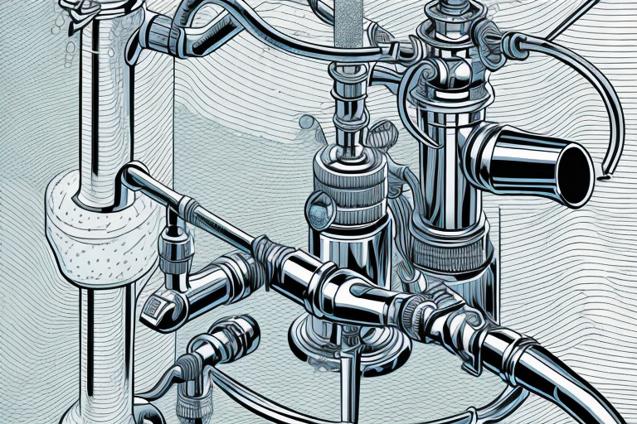
Don't let plumbing problems spoil your sailing adventures! Learn how to troubleshoot and prevent common issues with your boat's plumbing system.
The Plumbing Troubleshooting Techniques
Sailing the open seas with your family is an incredible experience, but it also comes with its fair share of challenges. One of the most common issues that sailors face is dealing with plumbing problems on their boats. In this article, we will discuss some of the most common plumbing issues that you may encounter while sailing and provide you with troubleshooting techniques to help you resolve them.
Table of Contents
- Introduction
- Understanding Your Boat’s Plumbing System
- Common Plumbing Issues and Troubleshooting Techniques
- Preventative Maintenance Tips
- Conclusion
Understanding Your Boat’s Plumbing System
Before diving into the troubleshooting techniques, it’s essential to have a basic understanding of your boat’s plumbing system. A typical boat plumbing system consists of the following components:
- Freshwater System: This includes the freshwater tanks, water pumps, water heaters, and the plumbing lines that supply water to the faucets, showers, and toilets.
- Waste System: This consists of the toilets, holding tanks, and the plumbing lines that transport waste from the toilets to the holding tanks.
- Bilge System: This includes the bilge pumps and plumbing lines that remove water from the bilge area of the boat.
Having a good understanding of these systems will help you identify and troubleshoot any plumbing issues that may arise during your sailing adventures.
Common Plumbing Issues and Troubleshooting Techniques
Clogged Drains
Clogged drains are a common issue on boats, especially in the galley and head. Food particles, hair, and other debris can accumulate in the drain pipes, leading to slow draining or complete blockages.
Troubleshooting Techniques:
- Manual Removal: If the clog is visible and easily accessible, you can use a pair of pliers or your fingers to remove the debris.
- Plunger: A plunger can be used to create pressure and dislodge the clog. Make sure to cover the overflow hole (if present) before using the plunger.
- Drain Snake: A drain snake can be inserted into the drain to break up and remove the clog. Be cautious when using a drain snake, as it can damage the pipes if not used correctly.
- Dismantling the P-Trap: If the clog is located in the P-trap (the curved section of the pipe under the sink), you can dismantle it to remove the debris. Make sure to place a bucket underneath to catch any water and debris.
Leaky Faucets and Fixtures
Leaky faucets and fixtures can waste a significant amount of water and cause damage to your boat if not addressed promptly.
Troubleshooting Techniques:
- Tighten Connections: Check all connections and fittings for any signs of leaks. Tighten any loose connections using a wrench.
- Replace Worn-Out Parts: Faucets and fixtures contain various parts, such as washers, O-rings, and cartridges, that can wear out over time. Inspect these parts and replace them if necessary.
- Apply Plumber’s Tape: If the leak is coming from threaded connections, you can apply plumber’s tape to create a watertight seal.
Toilet Problems
Toilet problems, such as clogs, leaks, and odors, can be particularly unpleasant on a boat. Here are some troubleshooting techniques for common toilet issues:
Troubleshooting Techniques:
- Clogs: Use a toilet plunger to dislodge the clog. If the plunger doesn’t work, you may need to use a toilet auger to break up the clog.
- Leaks: Inspect the toilet for any visible leaks. Tighten any loose connections and replace any worn-out parts, such as seals and gaskets.
- Odors: Regularly clean and sanitize the toilet bowl and holding tank to prevent odors. Make sure the vent line for the holding tank is clear and functioning properly.
Water Pump Issues
Water pumps are essential for supplying freshwater to your boat’s faucets, showers, and toilets. Common water pump issues include low water pressure, no water flow, and noisy operation.
Troubleshooting Techniques:
- Check Power Supply: Ensure that the water pump is receiving power by checking the circuit breaker and any inline fuses.
- Inspect the Pump: Visually inspect the pump for any signs of damage, such as cracks or leaks. Replace any damaged parts as necessary.
- Clean the Strainer: Many water pumps have a built-in strainer to prevent debris from entering the pump. Clean the strainer regularly to ensure proper water flow.
- Adjust the Pressure Switch: If the water pressure is too low, you can adjust the pressure switch on the pump to increase the pressure.
Water Heater Problems
Water heater problems can result in a lack of hot water or inconsistent water temperatures.
Troubleshooting Techniques:
- Check Power Supply: Ensure that the water heater is receiving power by checking the circuit breaker and any inline fuses.
- Inspect the Heating Element: The heating element can become corroded or damaged over time. Inspect the element and replace it if necessary.
- Check the Thermostat: Ensure that the thermostat is set to the desired temperature and is functioning correctly. Replace the thermostat if it’s faulty.
- Flush the Tank: Sediment can accumulate in the water heater tank, reducing its efficiency. Regularly flush the tank to remove any sediment buildup.
Preventative Maintenance Tips
To minimize the occurrence of plumbing issues on your boat, follow these preventative maintenance tips:
- Regularly inspect your boat’s plumbing system for any signs of wear, damage, or leaks.
- Clean and sanitize your freshwater tanks, holding tanks, and bilge area regularly.
- Avoid disposing of grease, food particles, and non-biodegradable items down the drains and toilets.
- Regularly service your water pumps, water heaters, and other plumbing components according to the manufacturer’s recommendations.
Conclusion
Plumbing issues are an inevitable part of the sailing lifestyle, but with the right troubleshooting techniques and preventative maintenance, you can minimize their impact on your adventures. By understanding your boat’s plumbing system and addressing issues promptly, you can ensure that your family enjoys a comfortable and hassle-free sailing experience.